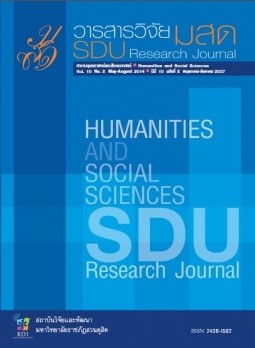การแปลเชิงกฎหมาย กรณีศึกษาวิเคราะห์การใช้ค�าว่า Shall ในฉบับแปลภาษาอังกฤษ ของรัฐธรรมนูญแห่งราชอาณาจักรไทย พ.ศ. 2550**
Keywords:
Legal Translation, Legalese, Plain English, Translation StudiesAbstract
General translation is a complicated language process. It poses the difficulty of
changing a text of the source language into the target language. The ultimate goal of it is to create the same effect of the source text on the target text. Legal translation imposes even more complexities of translating due to the nature of the law and its contingency upon a specific culture and language. This research explored the use of the English modal auxiliary verb ‘shall’ in the translated versions of the Thai Constitution B.E. 2550. It was based on the dynamic equivalence concept of Eugene Nida. The research findings demonstrated the
problematic use of ‘shall’ and how inappropriate use of it provided attributes to assist
translators in better understanding of legal translation.
References
Perspective, TEXTUS (Translation Studies Revisted), XII(2), 393-409. Kenneth, A. A. (2007). Contract Drafting. Making Sense of ‘Shall’. New York Law Journal.
Retrieved January 31, 2017, from http://adamsdrafting.com/downloads/nyljshall-101807.pdf.Kimble, J. (1992). The Many Misuses of ‘Shall’. Scribes J. Legal Writing, 61, 61-64. Kunnecke, M. (2013). Translation in the EU: Language and Law in the EU’s Judicial Labyrinth. The Maastricht Journal of European and Comparative Law, 2, 243-260. Nida, E.A. (1964). Toward a Science of Translating: With Special Reference to Principles and Procedures Involved in Bible Translating. Leiden: E. J. Brill. Sarcevic, S. (1997). New Approach to Legal Translation. London: Kluwer Law International. Sarcevic, S. (2000). Legal Translation and Translation Theory: A Receiver-oriented Approach. In La Traduction Juridique: Histoire, Theorie(s) et Practique, Geneva: Universite de Geneve Ecole de Traduction et d’Interpretation/ASTTI, 329-347. Stolze, R. (2013). Translation and Law. SYNAPS The Journal of Professional Communication, 28, 3-13. Tessuto, G. (2008). Drafting Laws in UK Settings: Implementing Plain English and Discourse. Retrieved January 20, 2017, from http://www.federalismi.it/document/08012008030941. pdf.








